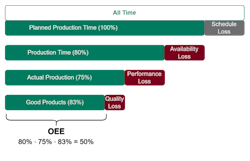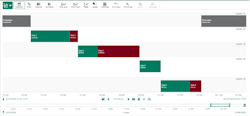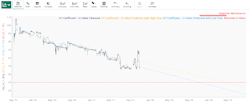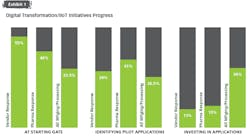Since gaining popularity in the 1980s, overall equipment effectiveness (OEE) has evolved from a rough calculation scrawled on a shopfloor blackboard to a critical key performance indicator (KPI), with an entire software market dedicated to monitoring and enhancing its score (Figure 1).
While methods for recording and monitoring OEE have changed over the decades, many companies continue to interpret results in the same way. However, progressive organizations are introducing modern technologies to reframe this metric from a target for operations into a valuable source of data that can be leveraged throughout an entire enterprise.
OEE in operations
In some circles, there is a misguided impression that OEE is the sole marker of a productive operation, but the situation is much more complex. Focusing on this single metric, rather than using it as a component of a broader framework, can be detrimental to a company’s overall objectives and bottom line.
When OEE is treated as the singular target, an incentive can arise for workers to manipulate inputs to achieve their targets, which decreases the quality of data collection and, ultimately, causes misguided data-based decision-making.
OEE is focused on the local optimization of an individual unit, but the end goal should be optimizing the entire production system. To achieve this, organizations must consider the context of wider topics, including energy consumption, market prices and sustainability goals.
At its most fundamental level, OEE is an indication of where to invest resources. For example, if the OEE is high on a bottleneck machine and there is demand for additional products, this indicates a capacity problem, and is a signal to invest in additional machinery. Conversely, if the OEE on the same machine is low, this indicates an opportunity to improve the machine’s effectiveness.
Furthermore, OEE is an effective measurement for assessing the current state of operations and potential for efficiency gains, but monitoring it in isolation does not produce improvements. When machines or processes fail, manufacturers need the ability to pinpoint root causes, predict future events, and take corrective measures to reduce repeat occurrences.
Breaking down data silos
When digitally maturing companies implement OEE improvement strategies, the primary barrier is typically data accessibility, with relevant information spread throughout various data sources, such as process historians, manufacturing execution systems and laboratory information management systems. In addition, significant cleansing and contextualization is often required to extrapolate meaning. This makes it nearly impossible to perform OEE- and continuous improvement-related analyses without complex and time-consuming data wrangling.
Fortunately, advanced analytics solutions can empower companies to access multiple data sources from one central location, and seamlessly combine data regardless of its source. This enables simple correlation analyses that provide users with rapid diagnostics to identify meaningful, actionable insights.
It’s crucial to consider the information an operations team requires and to provide them with relevant, real-time and auto-updating dashboards that reflect this. A custom-built dashboard (Figure 2) can highlight, for example, all excessive changeover durations, flagging them for investigation. These proactive investigations can significantly reduce turnaround time variability, which can result in more time in production.
Innovate to add value
With access to live data via advanced analytics solutions, process experts can expand and share their analyses beyond traditional tabular spreadsheets. These solutions are designed to work optimally with time series data, as well as provide seamless access to analytical solutions and insightful visualizations (Figure 3). Use cases that were previously discounted as too time-consuming become possible and new ideas can be imagined.
OEE remains a valuable metric for measuring equipment effectiveness. However, once data is collected, it must be translated into meaningful information before OEE can provide real business value. By empowering workers with collaborative advanced data analytics technologies, pharma can reach the high levels of efficiency required to remain competitive in today’s demanding markets.







